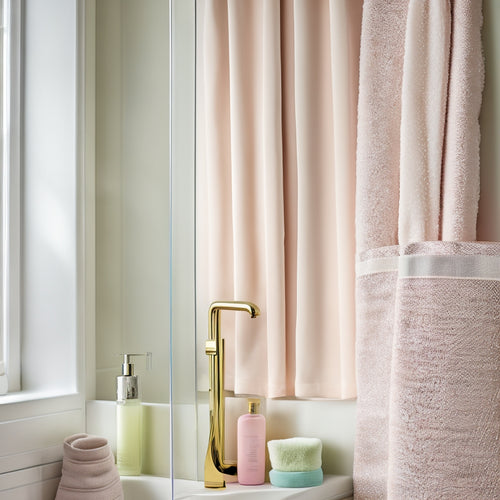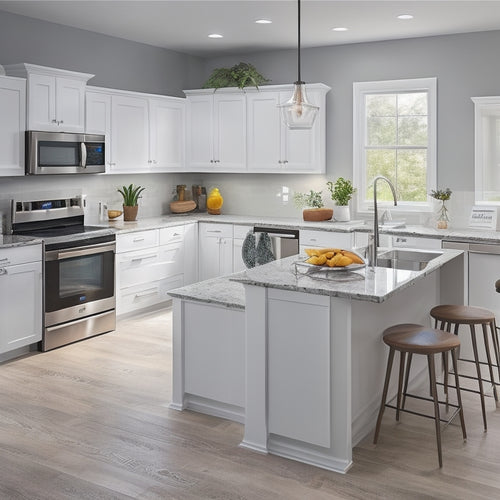
Craft Your Own Hanging Organizer With Ease
Share
To craft a functional and stylish hanging organizer, begin by gathering essential materials, including natural cotton duck canvas fabric, coordinating fabric for exterior baskets, and Peltex 72F ultra firm double-sided fusible stabilizer. Cut fabric pieces accurately, using precise measuring techniques and sharp cutting tools to prevent fraying. Construct the organizer base by sewing two canvas pieces together, then add functional pockets by fusing stabilizer to pocket bottoms and attaching coordinating fabric. Finally, hem the top edge and insert a wooden dowel for hanging. With these steps, you'll be well on your way to creating a customized hanging organizer that suits your specific needs and style.
Key Takeaways
• Choose the right fabric, considering color, texture, and pattern coordination for a visually appealing organizer.
• Cut fabric pieces accurately using precise measuring techniques and sharp cutting tools to prevent fraying.
• Construct a sturdy base by sewing canvas pieces together, pressing seams, and topstitching edges for added strength.
• Add functional pockets by fusing stabilizer to pocket bottoms, attaching coordinating fabric, and topstitching for a clean finish.
• Hang and finalize the organizer by hemming the top, inserting a wooden dowel, and choosing a suitable hanging option.
Gathering Essential Materials
To craft your own hanging organizer, begin by gathering a specific set of essential materials, including 1 yard of natural cotton duck canvas fabric, 3/4 yard of coordinating fabric for the exterior of the baskets, and 1/2 yard of Peltex 72F ultra firm double-sided fusible stabilizer.
Choosing fabrics that complement each other in terms of color, texture, and pattern is important for a visually appealing organizer. When selecting fabrics, consider the overall aesthetic you want to achieve and the items you plan to store. Exploring alternatives, such as cotton twill or linen, can also add unique character to your organizer.
Make sure you have the necessary materials before proceeding to the next step, as this will guarantee a smooth and successful crafting experience.
Cutting Fabric Pieces Accurately
Accurately cutting fabric pieces is a crucial step in creating a well-constructed hanging organizer. It begins with carefully measuring and marking the fabric according to the specified dimensions. Using precise measuring techniques, mark the fabric with a pencil or fabric marker to guarantee accurate cuts.
For the natural cotton duck fabric, cut two rectangles measuring 31 x 13 inches, three rectangles measuring 7 x 16 3/4 inches, and two squares measuring 5 x 5 inches. Employ sharp fabric cutting techniques to prevent fraying and distortion. Cut slowly and deliberately, following the marked lines to achieve clean, precise cuts.
Constructing the Organizer Base
With the fabric pieces cut, the next step in crafting a sturdy base for the hanging organizer involves sewing the two 31 x 13-inch canvas pieces together, creating a reinforced foundation that will support the weight of the pockets and their contents.
Using heavy-duty sewing techniques, align the two canvas pieces and pin them securely in place. Then, sew along the edges, leaving a small opening for turning the organizer right side out. Press the seams to create a crisp fold, and topstitch the edges for added durability.
This solid base allows for design variations, such as adding pockets of different sizes or shapes, and ensures a stable structure for storing and organizing items. By following these steps, you'll establish a sturdy foundation for your hanging organizer that will withstand daily use.
Adding Functional Pockets Easily
Your hanging organizer's functionality relies on the essential addition of pockets, which can be easily created by fusing the Peltex 72F ultra firm double-sided fusible stabilizer to the half-circle pocket bottoms. This vital step enables you to achieve ideal pocket organization.
Next, attach the coordinating fabric to the canvas, ensuring a harmonious fabric coordination. Clip the pocket rectangle to the half-circle pocket bottom and topstitch the top edge of the pocket. This will create a sturdy and functional pocket.
Repeat this process to create multiple pockets, allowing you to customize the size and layout to suit your specific needs. With these pockets in place, you'll be able to efficiently store and access your belongings, making the most of your hanging organizer.
Hanging and Finalizing Organizer
Once the pockets are securely attached, proceed to hem the 6x36-inch piece, ensuring a crisp fold and precise stitching to create a clean finish.
Insert the wooden dowel through the top hem, providing a sturdy base for hanging.
Choose your hanging option: select a hook or nail that suits your organizer placement, ensuring a secure hold.
Adjust the fabric as needed, smoothing out any wrinkles or creases.
Fill the pockets with items, customizing your organizer to suit your specific needs.
With these final steps, your hanging organizer is now complete, ready to provide a functional and stylish solution for your storage needs.
Frequently Asked Questions
Can I Use a Different Type of Fabric for the Hanging Organizer?
When considering fabric selection for your project, explore various textile options, weighing factors like durability, weight, and texture. While cotton duck canvas is recommended, you can substitute with sturdy fabrics like canvas, denim, or twill, ensuring they meet the project's structural demands.
How Do I Adjust the Size of the Pockets for Specific Items?
"A million possibilities await! To adjust pocket size, categorize items by type and size, then measure and mark pocket depth accordingly. Fold and sew pocket lines, ensuring a snug fit for each item, and voila! Customized pockets for ultimate organization."
Can I Add a Zipper or Velcro for Pocket Closures?
To incorporate secure fasteners, consider adding zippers or velcro as custom closures for pocket security. Simply attach zipper or velcro strips to pocket tops, ensuring proper alignment, and sew in place for a sturdy, reliable closure solution.
Is It Necessary to Use a Wooden Dowel for Hanging the Organizer?
The humble dowel, a stalwart sentinel of stability, but is it indispensable? Not necessarily. Consider dowel alternatives, such as curtain rods or tension rods, as viable rod substitutes to hang your organizer with equal elegance and ease.
Can I Machine Wash the Finished Hanging Organizer?
Before machine washing the finished hanging organizer, conduct a care label check and fabric durability test to confirm that the materials can withstand washing. Check the fabric's care instructions and test a small, inconspicuous area to avoid damage.
Related Posts
-

Craft Your Own Multi-Pocket Bath Caddy
We're about to craft a multi-pocket bath caddy that's both functional and stylish! To get started, we'll prepare our ...
-

Empowerment and Opportunities at USC JEP
The University of Southern California's Joint Educational Project (JEP) offers a wide range of empowerment and opport...
-

Kitchen Remodeling Made Easy: Free Planning Tools
I'm excited to transform my kitchen into a stunning space, but I know that without a clear plan, my dream can quickly...


